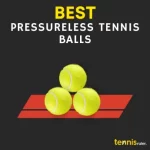Pressureless tennis balls vs pressurized balls or regular are different in terms of their constructions and way of play. Pressurized tennis balls have their own properties and effect on tennis players’ play style. While pressureless balls have their own.
Both are completely different and designed for specific purposes. If you are looking to purchase best tennis balls but are not sure about which tennis ball types are good. Read this article on Pressureless tennis balls vs regular to have any idea.
Table of Contents
Pressureless Tennis Balls Vs. Regular
Pressureless tennis balls are the tennis balls that are pressure-less, as the name showed. These balls do not have any internal pressure and made of thick rubber and other chemical compounds rubber. Pressure-less balls are used as practice balls for beginners, as these balls are cheap and easy to control.
Pressurized or regular tennis balls are the balls that have their core filled with pressurized gas inside the balls and made of thin rubber surrounded by fabric cover felt. These tennis balls are pressurized up-to 14 psi. Which makes them more bouncy and generates spin. Professional tennis players use pressurized balls for official games.
Specifications And Advantages Of a Pressureless Tennis Ball
- Pressure-less tennis balls are made with rubber with a layer of felt fabric on the top. These balls measure between 2.7 inches to 8 inches and weigh 56 grams, 59,4 grams, and 2 ounces.
- The maximum pressure of these balls is one psi, and the inner core is also made up of rubber which is why they are heavier.
- Pressure-less balls feel heavier when you strike them with a tennis racquet. They require a little more force and arm strength.
- These balls offer less bounce, even with a hard strike due to their heavy weight. The reason is that they aren’t pressurized.
- Pressureless tennis balls can become bouncier with time as the outer layer wears out, but the bounce isn’t as much as it is with the pressurized tennis balls.
- Pressure-less balls do not offer spin during the gameplay because of the dense rubber core. Adding to that, their spin and responsiveness increase when the outer felt covering wears away.
Downsides Of A Pressureless Ball
- Pressureless tennis balls are heavier than pressurized tennis balls.
- These balls need little more force to hit as compared to pressurized balls.
- These balls have less bounce as compared to the regular tennis balls.
- May result in arm injuries when using aggressively.
Specifications And Advantages Of a Pressurised Ball
- These balls are pressurized up-to 14 psi.
- They have a hollow core that is filled with pressurized air.
- These balls weigh and measure the same as the pressureless balls.
- These balls bounce more and generate spin on their serves.
- These are light weighted and require less force to hit.
- These balls are good to play any sort of competition.
- Good for any level and style of play.
- Perfect for all level skills players.
Downsides Of A Regular Tennis Ball
- These balls are not long-lasting as they lose their bounce over time.
- They are less durable balls as compared to pressureless one’s. These balls wear away easily.
- They are not good for general practice, as these balls do not provide consistent performance.
- Not good for beginners as they bounce more which is not easy for beginners to control.
- They are expensive as compared to pressure-less balls.
Frequently Ask Question | Pressureless Tennis Balls Vs. Regular
The fundamental difference between a pressureless and a regular or pressurized ball is evident from their names. Pressureless tennis balls are denser, have all rubber cores, and are heavier than regular balls.
The pressurized balls are filled with pressured gas, making them bouncier and lighter. On the contrary, the pressureless balls have a rigid rubber core, making them denser, heavier, and less bouncy.
While you cannot argue on whether a pressureless ball is better or a regular one, however, most people prefer regular balls for their tournaments and official competitions because they are bouncier;
Other than that, the regular balls feel lighter, due to which they are easy on the arms. On the other hand, pressure-less balls are good for practice sessions because they are long-lasting and require excellent arm strength.
While the regular tennis ball, also known as a pressurized ball, is preferred by most people, the major setback of these balls is that they are not long-lasting. Due to the constant impact, abrasion, and friction, the pressured gas filled in the core of the ball escapes from the tears, which leaves them up to no good.
After some time, they lose their bounce and become useless. Therefore you need to keep replacing a pressurized ball for every match.
While a pressureless ball is known for its durability, long life span, and spin, the majority of people don’t like them for its hardness.
As the core is made with tough rubber, they feel heavier on the arm and require significant force to strike them with a racquet. Pressureless tennis balls are mostly restricted to practice sessions because they really tire you at the end.
Final Thoughts
Pressured balls and pressureless balls are both approved and preferred by professional players because they have their own qualities and domain. However, some might give preference to one over another. You cannot decide which one is the best;
It depends on your strength and skill level which tennis ball will be the best for you. Pressureless balls are heavier, less bouncy, spin more, and are long-lasting. On the other hand, the regular balls are less dense, feel lighter on the arm, offer great spin, are bouncier, and have a low life span.
Pressureless balls are good to use as training balls. Pressurized balls are good for official tournaments as they are more gentle on fast court surfaces. Pressure-less balls are good to practice with the tennis balls machine as they are heavier and provide consistent performance.
Now you have a complete understanding of pressureless tennis balls and pressurized balls. It’s up to know which one you like the most. However, I would strongly advise selecting the ball that aligns with your skill level.
If you are at the beginner level, opting for pressureless balls would be advantageous as they are cost-effective and possess enhanced durability. Conversely, if you are an experienced player, I would recommend opting for pressurized balls.





